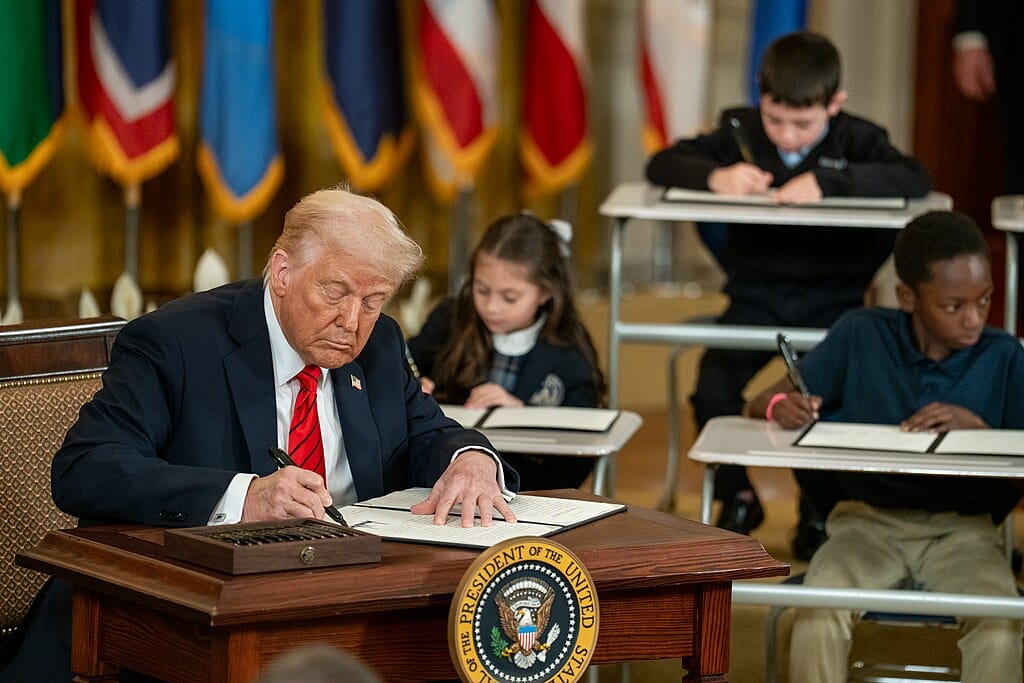At a White House ceremony on March 20, surrounded by schoolchildren in desks set up for the occasion, President Donald Trump signed an executive order with the stated intent of dismantling the U.S. Department of Education.
"We're going to eliminate it," the president said of the Cabinet-level agency, which has a budget of $268 billion and is responsible for distributing federal education funds, enforcing civil rights laws and supporting educational research.
In South Dakota, like most of the nation, the executive order was met with expressions of uncertainty among educators, parents and students who searched for concrete answers amidst the politics.

Would the actions reduce Title I funding, which provides resources for schools with high percentages of low-income students? What about federal dollars earmarked for special education or college student loans administered by the Department of Education?
Those questions are particularly poignant in South Dakota, whose $433 million in federal education funds in 2021-22 represented 21.7% of the state’s total K-12 education budget. That percentage was the second-highest in the nation behind Mississippi (23.3%), partly due to South Dakota's significant Native American population.
Coming off a state legislative session that produced a 1.25% education budget increase – lower than the current inflation rate – and several attempts to allow state funds to be used for private school vouchers, public education advocates describe themselves as being on the defensive.
“There seems to be an attack on public education," said Sandra Waltman, director of public affairs for the South Dakota Education Association, an affiliate of the National Education Association, the nation’s largest teachers union.
"South Dakota's public schools are where 83% of our students attend. They are the heart of our communities, so this is very concerning to us, and it should be concerning to the people of South Dakota."
U.S. Sen. Mike Rounds, who proposed legislation in November to eliminate the Department of Education, countered that the action is aimed at cleaning up cumbersome federal bureaucracy as a means of improving academic outcomes.

Gov. Larry Rhoden and South Dakota Department of Education Secretary Joe Graves have both voiced support for President Trump's "reduction of federal influence in education," as Graves expressed it in a statement to News Watch.
"Closing the U.S. Department of Education does not mean cutting off funds from those who depend on them," said Graves, a former superintendent of the Mitchell School District. "K-12 students, students with special needs and others who rely on essential programs will continue to receive federal funding as they have before."

News Watch talked to state education officials, school administrators, teachers and politicians to provide insight on the role of the U.S. Department of Education and how proposed changes could impact South Dakota.
Each question and answer below is covered in its own section that can be expanded to show the details by clicking on the title or the down arrow.
What is the role of the U.S. Department of Education?
Congress established the department in 1979 and President Jimmy Carter signed into law as an effort to consolidate federal education efforts.
Nationally, federal funds contribute about 10% of overall K-12 funding, with most money coming from state and local tax dollars. The agency’s 2024 fiscal year budget of $268 billion represented roughly 4% of total federal government spending.
For colleges and universities, the Department of Education manages the federal student loan portfolio, which includes approximately $1.5 trillion in student loan debt for more than 40 million borrowers. It also oversees the Pell Grant, which provides aid to students below a certain income threshold.
Through its Office for Civil Rights, the department conducts investigations and issues guidance on federal laws such as Title IX, which prohibits gender-based discrimination in education programs receiving federal assistance.
How much federal education funding does South Dakota receive?
South Dakota’s K-12 schools received $433 million in federal funds for the 2021-22 school year, according to the National Center for Education Statistics.
By comparison, the schools received about $954 million from local sources (primarily property tax revenue) and $612 million in state funds that school year.
That 21.7% share of federal money for total education funding was boosted by COVID-19 pandemic-related aid, contributing to a significant increase from 13.7% in 2018-19.
Not all school-related federal money comes from the Department of Education. School lunch programs are funded through the Department of Agriculture and early educational programs such as Head Start are handled by the Department of Health and Human Services.
Of the Department of Education money, the most significant expenditures are for Title I grants to support low-income students and Individuals with Disabilities Education Act (IDEA) funds for special education and other services for disabled students.
How much do South Dakota schools rely on Title I funds?
The grants are distributed to school districts based on the number of low-income students using U.S. Census Bureau data and school poverty rates such as the percentage of students receiving free and reduced-price lunch.
In South Dakota, schools in larger cities or those based on Native American reservations typically receive larger allotments of Title I funds. In 2024-25, the state’s largest Title I allocations went to public school districts in Sioux Falls ($6.9 million), Rapid City ($6 million), Oglala Lakota County ($5.1 million) and Todd County ($4.6 million). The next highest was Chamberlain at $1.4 million.
Rob Monson, executive director of the School Administrators of South Dakota, said educators make staffing decisions each spring for the following school year and need to factor Title I and IDEA funds into their decision-making.
“I was the principal in Parkston for 15 years, and every year we would say, 'OK, here’s our Title I allocation, what can we afford this year?'" Monson said. "For us, it would typically be a couple of staff members and very limited supplies, maybe a (professional development) piece where you would send those staff people to a Title I conference. There wasn't a lot of fluff, at least in our budget. It was a very narrow margin on what you could afford.”
Can a president eliminate the Department of Education?
The executive branch lacks that constitutional power. Congress established the department, and it would take congressional action to dismantle it and shift its functions to other agencies.
Such action during the current administration would likely face obstacles even with a Republican-controlled Congress. In the Senate, 60 votes are needed to overcome filibusters and advance measures to final votes.
As for appropriated education funding such as Title I being discontinued, that also falls under the power of Congress, not the executive branch. There has been no proposal to cut such funding for the 2025-26 school year.
U.S. Education Secretary Linda McMahon issued the following statement on March 20, the same day President Trump signed the executive order:
“Closing the department does not mean cutting off funds from those who depend on them – we will continue to support K-12 students, students with special needs, college student borrowers, and others who rely on essential programs. We’re going to follow the law and eliminate the bureaucracy responsibly by working through Congress to ensure a lawful and orderly transition."
Why does President Trump want to shut it down?
Eliminating the Department of Education has been a Republican talking point essentially since its inception, with Ronald Reagan pledging to dismantle the agency during his successful presidential run against Carter in 1980.
A Democratically controlled House of Representatives prevented Reagan from achieving that goal. But conservatives have continued to decry the federal government’s involvement in state and local school district decisions, with an eye toward academic outcomes.
Analysis of 2024 test scores by the National Center for Education Statistics showed that America’s children have continued to lose ground on reading skills since the COVID-19 pandemic and have made little improvement in math.
South Dakota reading scores dropped in 2024 compared to 2022 at both the fourth- and eighth-grade levels, while remaining at or above the national average. Math scores for eighth-graders in the state remained about the same as 2022, while fourth-grade test scores improved slightly.
Trump’s current actions were presaged by Project 2025, a blueprint from the conservative Heritage Foundation, which envisioned the Department of Education's role merely as a “statistics-gathering agency that disseminates information to the states.”
Trump also said during his 2016 presidential campaign: “No, I’m not cutting services, but I’m cutting spending. I may cut the Department of Education.”
What sort of changes is Sen. Rounds proposing?
Under his "Returning Education to Our States Act," South Dakota's junior senator has proposed eliminating the Department of Education and redistributing "all critical federal programs under other departments."
“The federal Department of Education has never educated a single student, and it’s long past time to end this bureaucratic department that causes more harm than good,” Rounds said in announcing his plan.
The bill would put the Department of Health and Human Services in charge of special education and also impact aid, which compensates schools for federally connected students or residents not living on taxable property.
The Department of the Interior would absorb Office of Indian Education responsibilities, while Pell Grant and federal loan administration would be shifted to the Department of the Treasury. The Department of Justice would handle Title IX complaints and other civil rights enforcement.
Rounds has also proposed "returning education decisions to the states" in the form of block grants that would allow for more flexibility in how some federal education money is spent.
That's a concern to public education advocates, who said putting Title I and other federal funds in the hands of state legislators or the South Dakota Department of Education could lead to that money being shifted to voucher programs encompassing private or homeschooled instruction.
"The reason that the U.S. Department of Education was created was to ensure that all students have access to quality education and that poor communities had the resources to provide that education," said SDEA's Waltman.
"If you turn those responsibilities over to the states, and I'm assuming the state Legislature would have a say in that, would they hold true to the purpose of (low-income) Title I grants? I'm not sure that would be a priority."
What are other South Dakota congressional members saying?
In a statement to News Watch, U.S. Rep. Dusty Johnson said that the "Department of Education is not meeting the needs of America’s school children." The congressman used the word "restructuring" rather than "eliminating" or "dismantling" the agency.
"Reform is needed, and I’m open to restructuring the department," Johnson said. "That being said, we have to make sure any restructuring doesn’t hurt important functions like Pell Grants, impact aid and special education.”
U.S. Sen. John Thune told News Watch in a statement that the Trump administration will find a "willing partner" in Congress to make sure that education is "focused on improving outcomes for students and families, not D.C. bureaucrats."
“I have long believed that education resources and decision-making would be best left to teachers and school administrators who are on the ground and closer to the students who are being served," Thune added. "While local control is best, I believe there are certain limited educational responsibilities for the federal government that should be preserved.”
Troy James, principal of Beresford Elementary School, 35 miles south of Sioux Falls, met with Thune, Rounds and Johnson on March 10-12 in Washington. He was joined by other South Dakota educators as part of the National School Leaders Advocacy Conference.
When the group asked Rounds about funding cuts as part of his plan to eliminate the Department of Education, James said, the senator "assured us that they would not be cutting money to the states, only sending that money through other departments."
"I think we're confident in the assurances we received from Sen. Rounds and others that the money that we need to serve our kids will still be coming," James told News Watch. "It's just a matter of who's writing the check."
How will South Dakota's colleges and universities be impacted?
The most pressing concern among South Dakota higher education officials involves federal student aid programs and work study initiatives administered through the Department of Education.
For the 2023-24 school year, South Dakota's six public universities had 5,283 Pell Grant recipients for $26.3 million, while 13,051 students received federal student loans totaling $122.9 million.
"Our students benefit greatly from those programs and the financial resources that come with them," Nathan Lukkes, executive director and CEO of the South Dakota Board of Regents, told News Watch.
"We'd hate to see anything negatively impacting their availability. Based on everything that's coming out of the White House and Washington to date, every indication is that there is no intention to alter the provision of those resources."
The ability to distribute funds efficiently, a challenge in the best of times, will be watched closely now that the Department of Education's staff has been cut approximately in half since McMahon took over the agency.
Also of interest to colleges and universities is the Department of Education's Office for Civil Rights, which enforces Title IX as part of the law's mandate to prevent sex-based discrimination and provide equitable opportunities for female athletes as well as other legal protections.
Critics said that shifting that role to the Department of Justice could impact the rigor of anti-discrimination efforts, despite recent emphasis from Trump and other Republicans on protecting women's and girls sports.
"I think we're in a solid place in South Dakota in terms of not dealing with some of the challenges or issues you might see surfacing in headlines nationally," said Lukkes.
"The question that remains is similar to some of the other programs within the Department of Education at the moment. What is the plan for appropriately staffing, managing and providing oversight in that area moving forward, whether it gets kicked down to the state level or shifted over to another federal agency. That's the question that people are waiting to see the answer on."

Correction: The original version of this story used the wrong year's federal education funding data in the graphic toward the top of this story. South Dakota received 21.7% of its education funding from the federal government during the 2021-22 school year.
The Associated Press contributed to this story, which was produced by South Dakota News Watch, an independent, nonprofit organization. Read more stories and donate at sdnewswatch.org and sign up for an email every few days to get stories as soon as they're published. Contact Stu Whitney at stu.whitney@sdnewswatch.org.







